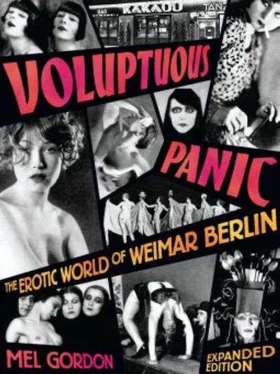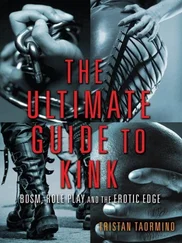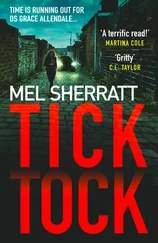From Renaissance times, Gypsies and Jews were closely identified with white slavery in Central Europe. By 1920, their participation was largely vestigial in Germany. Romany culture became submerged in gooey Viennese, Hungarian, Parisian, and Spanish renditions. Gypsies themselves disappeared from German urban life although they were the theme of a vast, mostly invented, erotic literature.
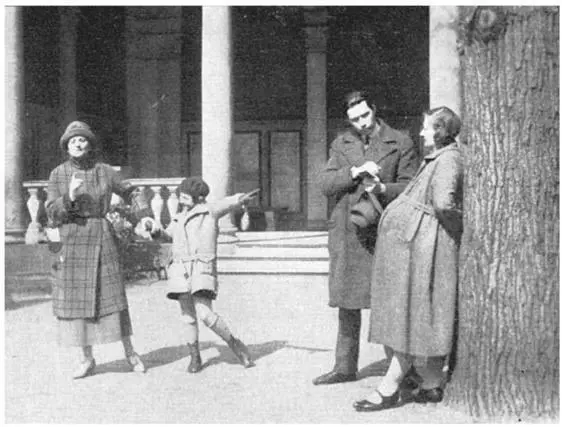
Posed photograph of a Münzi
Weimar Berlin had a large Jewish population (around 9% if one includes Ostjuden [immigrants from Eastern countries] and thoroughly assimilated/converted /hidden Jews). While they dominated certain cultural fields in pre-Nazi Berlin, especially publishing, law, medicine, theatre, graphic art, cinema, music, architecture, and popular entertainment, relatively few Jews were still involved in common prostitution with the exception of two picturesque types: Kupplerinnen (procuresses) and Chontes —zaftig whores from southern Poland. In general, Chonte-Harbors (Jewish brothels) were not well regarded in Berlin’s sex guides but they appeared to attract a sizable working-class and indigenous clientele.
The other varieties of indoor Berlin prostitutes were substantially higher-brow. Fohses frequently made their initial contacts in public gatherings, negotiating prices and scenes, but were never considered streetwalkers since their work fell under the (even then) comic rubric of “Massage Therapists.” Upscale Demi-Castors were essentially the picky Half-Silks of the closed-door brothel set. And Table-Ladies (Berlin Geishas) applied their exclusive trade in snooty nightclub backrooms and at bachelor pads.
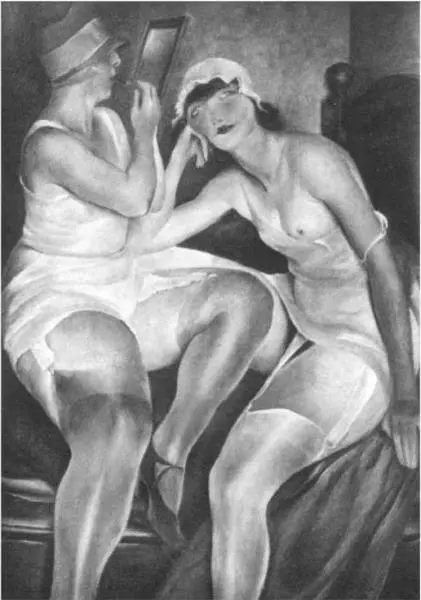
Albert Birkle, Fohses
Sophisticated het tourists came to Berlin for erotic “specialties.” Luigi Barzini’s social memoir, The Europeans, captured this Weimar excess best in his farcical recollection of the Alex:
I saw pimps offering anything to anybody, little boys, little girls, robust young men, libidinous women, or (I suppose) animals. (The story went around that a male goose of which one cut the neck at the ecstatic moment would give you the most delicious, economical, and timesaving frisson of all, as it allowed you to enjoy sodomy, bestiality, homosexuality, necrophilia, and sadism at one stroke. Gastronomy too, as one could eat the goose afterward.)
Actually, in Berlin North, Alphonses and independent whores organized their perverse attractions in the manner of market-day vendors: like-with-like. Mehnerstrasse (site of the ice cream/masturbation shop) was known as “Old Mädchen Street.” For those with an itch for mature K-Girls (40- to 60-year-olds but looking considerably older) or a sympathetic motherly touch, there were three infamous Transient-Quarters and a few storefront chambers of the same. On Landwehrstrasse were only beautiful stout Beinls . Weighting an average of 220 pounds, these gorgeous street creatures in groups of three and four provided ideal subject matter for smirking painters of the Neue Sachlichkeit ilk.
Other corners near the Alex (like the faraway Tauentzienstrasse) were talking grounds for mother-and-daughter crews. In Berlin North, however, the age difference between the parent and child was striking and even exaggerated. The amusing twin-sister look of the T-Girls faded on Gollnowstrasse into a dark incestuous fantasy. One French journalist, Jean Galtier-Boissiere, described, in sickly pornographic detail, the creeping horror of feeling a nine-year-old’s tiny, but proficient, fingers stroking his upper thigh while her broken-toothed mother covered with his face with hot sucking kisses.
Two street types were deemed important enough to be granted a separate nomenclature: Gravelstones and Münzis . Like Berlin’s war-wounded, the Gravelstones had their own hideous allure. Outcast prostitutes with grim deformities—acid-scarred faces, hunchbacks, crippled or missing limbs, disfiguring skin conditions—they created their own informal society on Oranienburgstrasse in Berlin North. By the late Twenties, the Gravelstones came into their own; men in chauffeured limousines appeared with some frequency to chat with them and if their malformation proved compelling and unusual enough, an all-night arrangement was gamely struck.
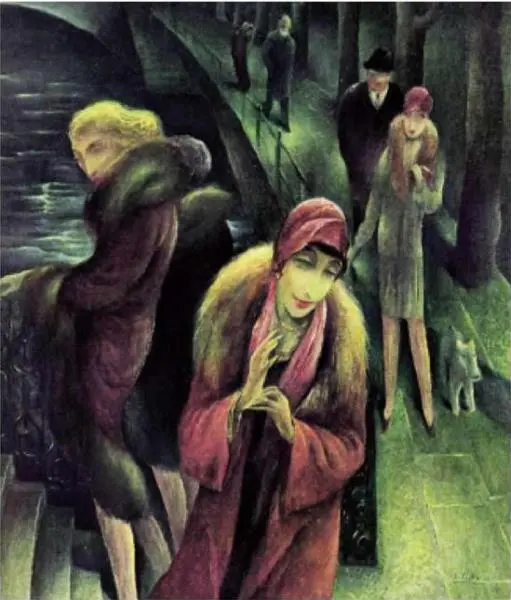
Waiting at the Bridge , 1931
Münzis were knocked-up streetwalkers who advertised their condition on Münzstrasse, about seven blocks from Gravelstone territory. Conscious of their temporal appeal, the Münzis charged triple rates for sessions and organized themselves on the “Münz” (“Coin”) according to their stage of pregnancy. Like the Boot-Whores , the Münzis became a much in-demand tourist sight.
S&M prostitutes publicized their presence in trade newspapers and hotel flyers. Dominas were to be found in “Body Culture” clinics and sometimes approached randy foreign couples in lesbian and transvestite nightclubs. More discreet were the Racehorses , young masochistic prostitutes, who were billed as “teachers” at “Institutes for Foreign Language Instruction” or “masseuses” in Berlin South “Beauty Salons.” Minettes , unlike their French namesakes, enacted standard domination and fetish scenarios (i.e., angry boarding-school mistress; new secretary; enraged customer; Madga Lupesco and King Carol; best friend’s mother; industrial spy; blackmailing student; boss’ sadistic daughter; old girlfriend) for hefty fees in fashionable hotel suites.

A Domina
Child prostitution was a searing social issue long before and after the Inflation era. It involved both female and male children, sex-workers’ progeny, runaways, and troublesome adolescents. There seemed to be almost no bottom age for those seeking physical companionship with children. And virtually no end to willing girls and boys.
One unsettling example: In January 1932, a Berlin tabloid exposed a “prostitute ring” of ten-year-old girls who worked independently at the Alex U-Bahn Station. Each girl stood demurely inside a subway entrance foyer, hoping to catch the eye of an impulsive Cavalier (heterosexual pederast) on his way to work. Astonishingly, the prepubescent vixens had been whoring unimpeded for months before the story broke.
Of course, all major cities had to confront this pressing and psychologically debilitating civic problem, particularly during hard times. But in Berlin the quandary of kiddy-prostitution was partly resolved by a more cynical, free-market approach: the opening of child brothels.
How many children were actually pressed into sexual service/slavery is unknown. Magnus Hirschfeld reported on one such lucrative operation on Alexandrienstrasse, where a “rapacious harem” of 14-year-old Russian girls “lewdly beguiled” wealthy Cavaliers from Berlin’s industrial elite. The house was, remarkably, shut down by the municipal court after a sensational trial shrouded in political intrigue and late-night government machinations.
Читать дальше
